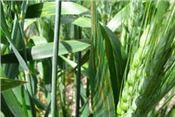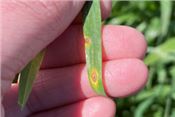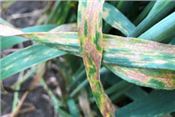Springing Into Foliar Diseases In Wheat
DR. KAITLYN BISSONNETTE
COLUMBIA, MO.
Winter wheat in the stem elongation phase approaching flag leaf in much of the state making the question of disease control for leaf disease of importance. In Missouri, there are multiple fungal diseases that can potentially compromise the flag leaf if conditions are ideal: stripe rust, tan spot, and Septoria leaf blotch. These fungal diseases favor cool, humid conditions for development; however, there are some key differences to note when tracking their spread and appearance in wheat fields.
The pathogen that causes stripe rust is a biotrophic fungus meaning it requires a living host to survive. It survives in the southern states and Central America where volunteer wheat can survive through the winter months and is not subjected to cold winters like we experience in Missouri most years. Often, stripe rust makes its appearance in Missouri as we approach or enter the flag leaf stage of development.
This season, reports of stripe rust began in southeast Kansas starting April 10, 2021. Early infection of the flag leaf or prior to flag leaf emergence can result in substantial yield loss if conditions are favorable and the cultivar is susceptible. Overnight temperatures between 50 and 60°F favor disease development especially with heavy due or irrigation present. Once nighttime temperatures rise above 73°F, infection slows. In Missouri, several commercially available cultivars carry resistance to stripe rust infection, so it is important to note which variety you have planted in your field when making management decisions.
Unlike stripe rust, the tan spot pathogen overwinters in stubble and spreads via spores present at the soil surface. Disease development starts in the lower leaves as spores are splashed to new leaves allowing the disease to move up the canopy. Early tan spot symptoms have begun developing in wheat trials at the Bradford Research Center in Columbia, MO as of the week of April 11, 2021 following persistent rain events that have led to high levels of relative humidity in the lower crop canopy. It is also important to note that tan spot can be mistaken for Septoria leaf blotch upon first examination. A defining characteristic of tan spot is the yellow halo around leaf lesions.
Septoria leaf blotch also begins in the lower canopy and can co-occur with the pathogen that causes Stagonospora glume blotch. Cool, humid weather around 72 degrees Fahrenheit and continued humidity in the canopy, especially in fields with irrigation or where extended periods of rain favor disease development. If conditions are ideal moving into the flag leaf and heading stages, infection can progress up the canopy. If head infection by the pathogen occurs, this is referred to as Stagonospora glume blotch and can result in quality losses in the grain. Cool temperatures and adequate rainfall that have been experienced in the state thus far have led to ample developmental conditions for Septoria leaf blotch in many winter wheat fields in Missouri. If conditions warm and rainfall decreases, risk of movement up the canopy will be decreased. It is important to note the differences in lesion development as compared to tan spot. Septoria leaf blotch generally lacks the yellow halo that is present in tan spot and follows the leaf veins. Additionally, tan spot is not associated with head infection.
Protecting the flag leaf from foliar disease is important for maintaining photosynthesis during the grain fill period. It is also important to understand that strobilurin fungicides applied at the flag leaf stage can contribute to increases in FHB toxins during the grain fill period. However, if conditions warrant a fungicide application, it is important to factor in all aspects of a management plan to make fungicide application decisions. ∆
DR. KAITLYN BISSONNETTE: Department of plant pathology, University of Missouri

Figure 1 Stripe rust pustules developing on wheat leaves. Pustules line up in stripes on the leaf surface and are yellow-orange in color.
Photo by Kaitlyn Bissonnette

Figure 2 Lesions of tan spot developing on a young wheat leaf. Note the large yellow halo surrounding the lesion and that the lesions do not follow the leaf veins.

Figure 3 Septoria leaf blotch lesions with black pycnidia present in the lesions. The lesions follow the leaf veins and minimal yellowing is present surrounding the lesions